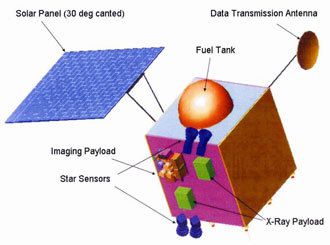-
 Growth twin
Growth twin
-
 PlayStation 3
PlayStation 3
-
 Polyprotein
Polyprotein
-
 MVIC
MVIC
-
 Dolerite
Dolerite
-
 RNA polymerase
RNA polymerase
-
 Enolase
Enolase
-
 ADP
ADP
-
 Vacuum
Vacuum
-
 Gustatory
Gustatory
-
 Lymphoid
Lymphoid
-
 Amoeba
Amoeba
-
 Communications controller
Communications controller
-
 Pacific rosewood
Pacific rosewood
-
 Pseudomorph
Pseudomorph
-
 Spirit
Spirit
-
 Cadherin
Cadherin
-
 Gravitation
Gravitation
-
 CAD
CAD
-
 Autopsy
Autopsy
-
 Pistil
Pistil
-
 Magnetic field
Magnetic field
-
 Bone grafting
Bone grafting
-
 Taikonaut
Taikonaut
-
 OPEC
OPEC
-
 Barbs
Barbs
-
 Cryptorchidism
Cryptorchidism
-
 Listeria
Listeria
-
 M97
M97
-
 Codec
Codec
Chandrayaan-1
Chandrayaan-1 is an Indian automatic lunar probe (ISRO, Indian Space Research Organization) launched from the Sriharikota base on 22 October 2008, on a PSLV rocket equipped with Psom-XL thrusters. It was initially placed in a 500 x 5000 km elliptical orbit around the Moon on 4 November 2008; this was gradually brought to a 100 x 100 km circular polar orbit on 8 November 2008.
Its mission was to completely map the surface of the Moon, analyse the mineralogical composition of the soil, study the Moon's crust to better understand its evolution and to look for water in the polar regions. The data from Chandrayaan-1 was also used to make 3D maps of some regions of the Moon, and will be used to analyse magnetic anomalies detected by other missions.
Instruments on board:
- HySI spectral imager (India)
- TMC mapping camera (India)
- LLRI laser altimeter (India)
- CIXS low energy X-ray spectrometer (ESA/RAL British laboratory)
- HEX High energy X-ray spectrometer (India)
- SIR-2 infrared spectrometer (ESA/Max Planck Institute)
- M3 infrared spectrometer (United States)
- Cena neutral atom detector
- Sub KeV Atom Reflecting Analyser (SARA), an apparatus for studying the interaction between the solar wind and the lunar surface (ESA/Swedish Institute for Space Physics/Indian Institute for Space Physics)
- MiniSAR S-band radar to search for water ice at the poles (United States)
- SXM environmental energetic particle monitor (Bulgaria)
The probe mission was planned to last two years but it ended after 312 days owing to a technical failure, after completing 95% of its objectives.
Chandrayaan-1 also carried an impactor designed to strike lunar soil near the south pole, which sent images and data on the very weak atmosphere during its descent.
 Artist's impression of Chandrayaan-1.
(Credits: Indian Space Research Organization)
Artist's impression of Chandrayaan-1.
(Credits: Indian Space Research Organization)
Latest
Fill out my online form.



